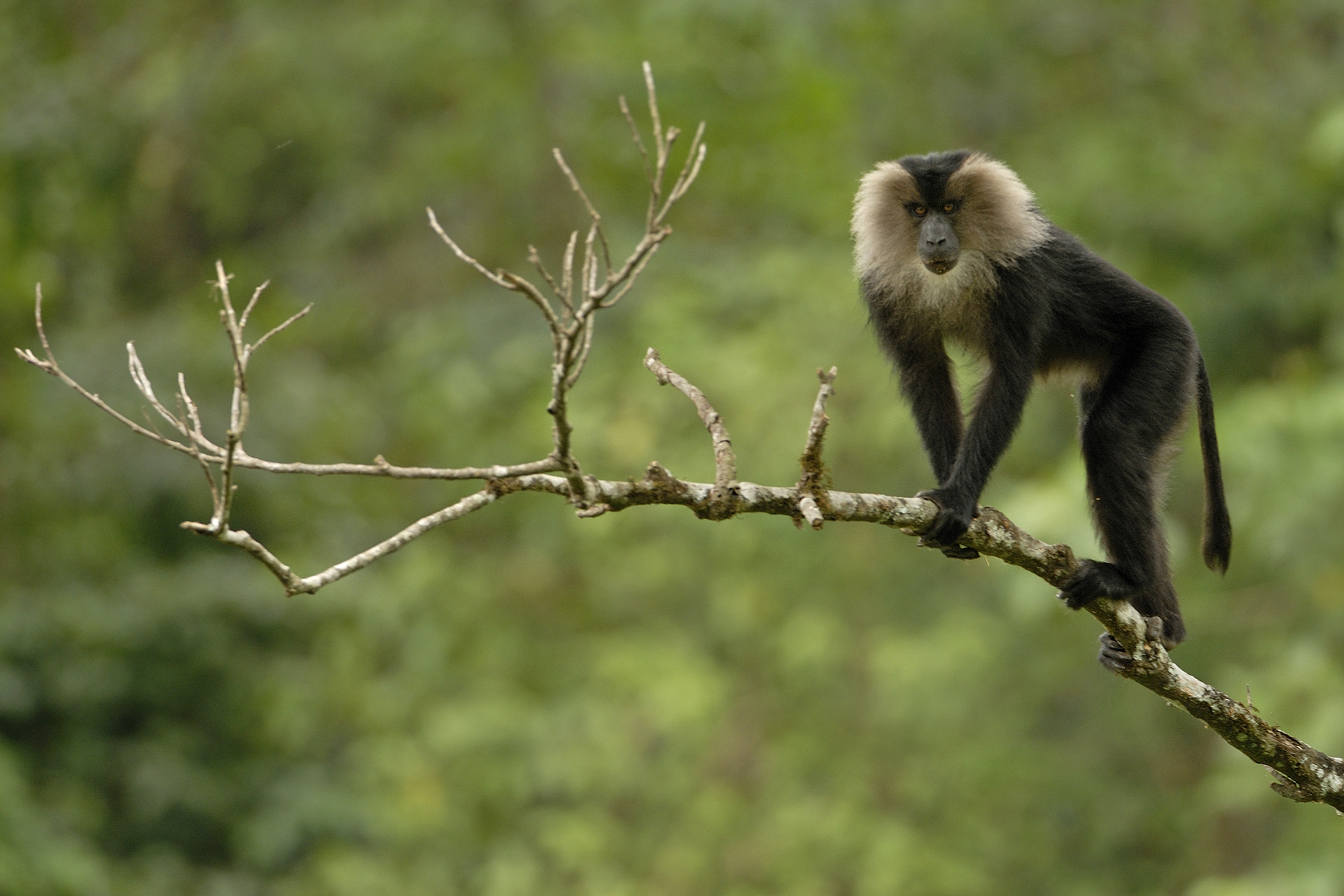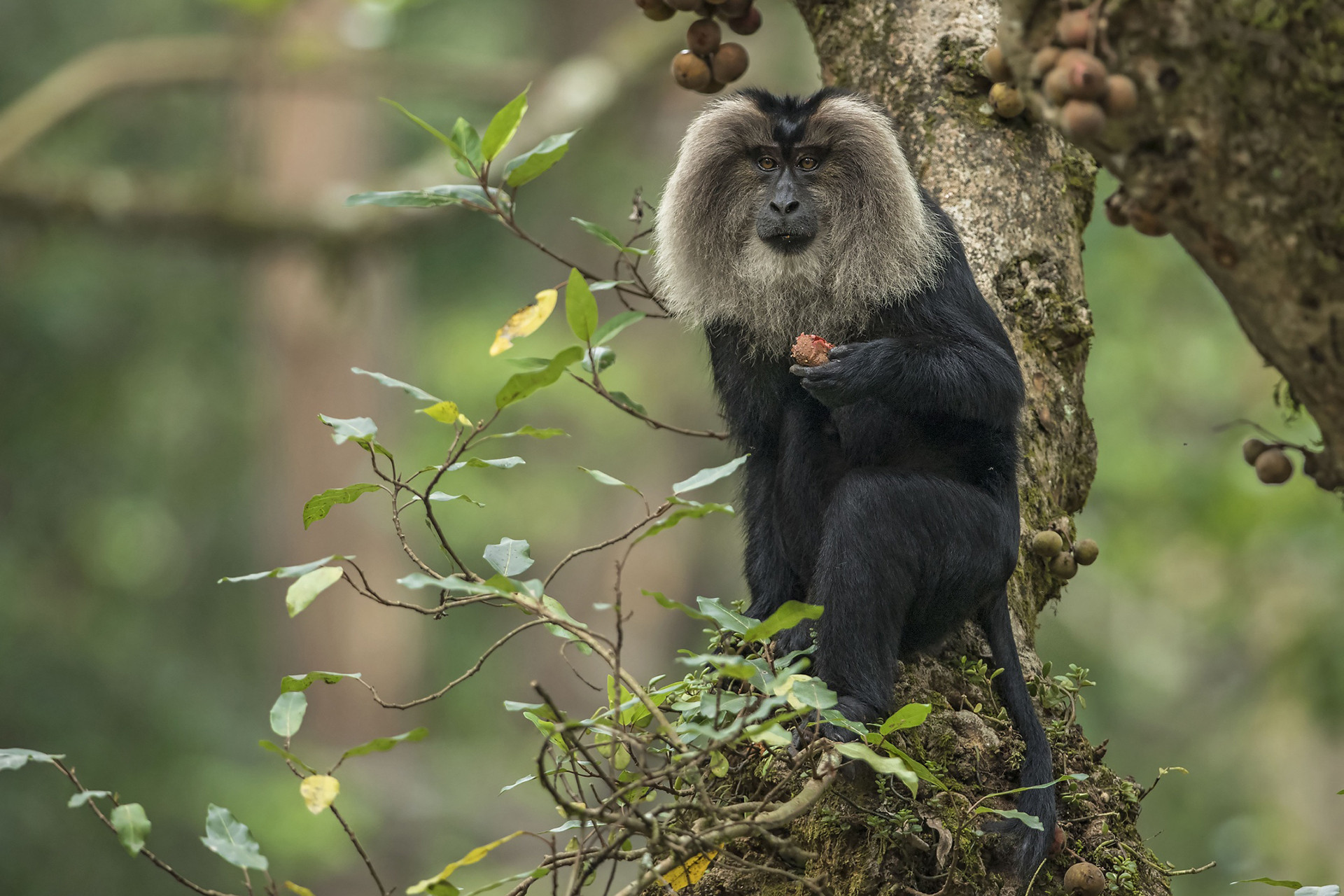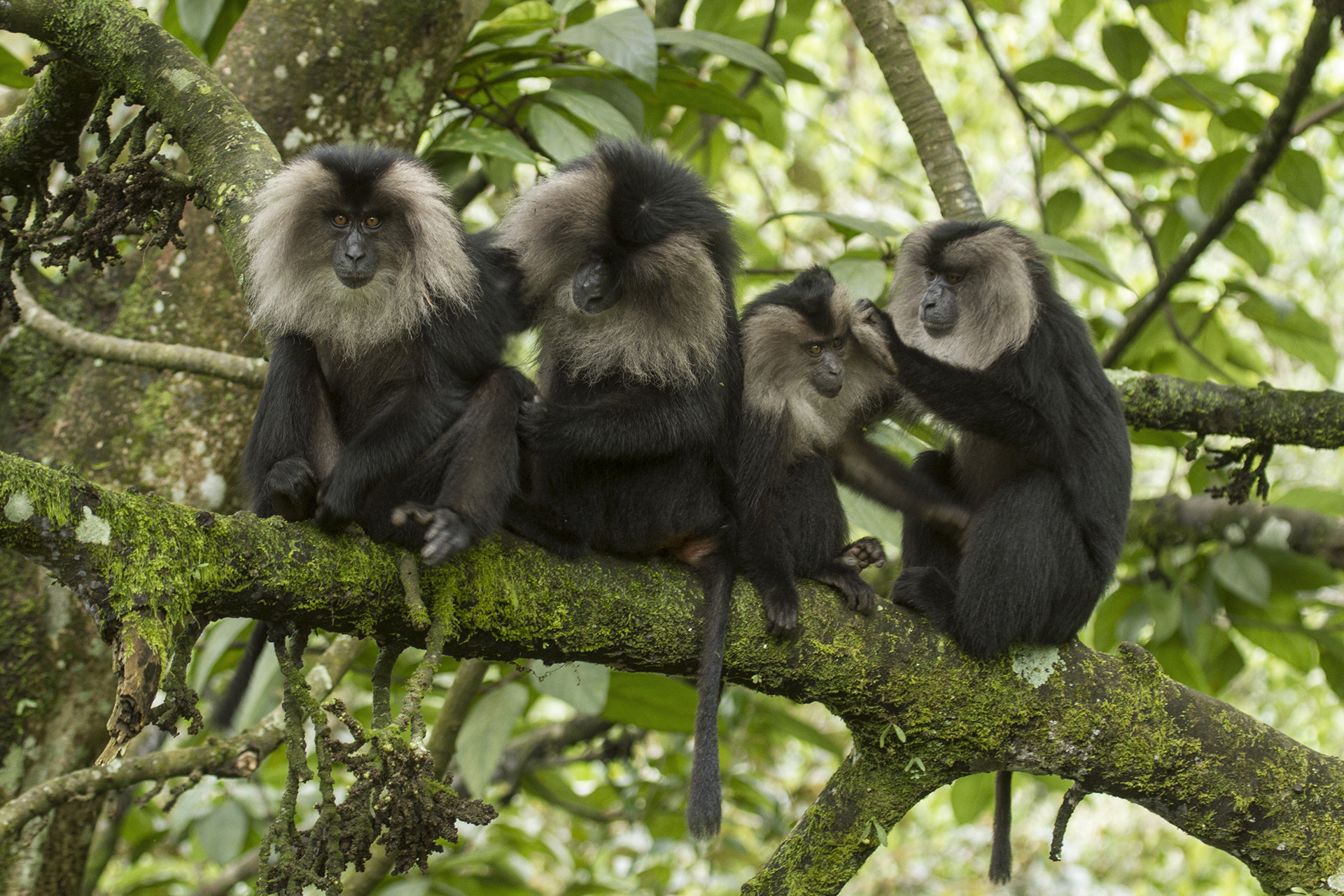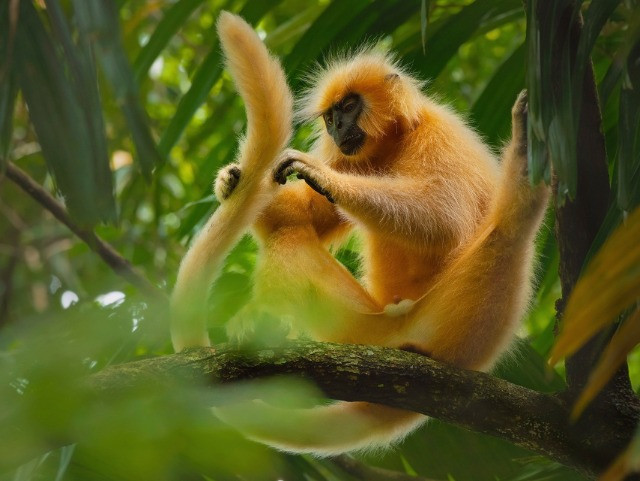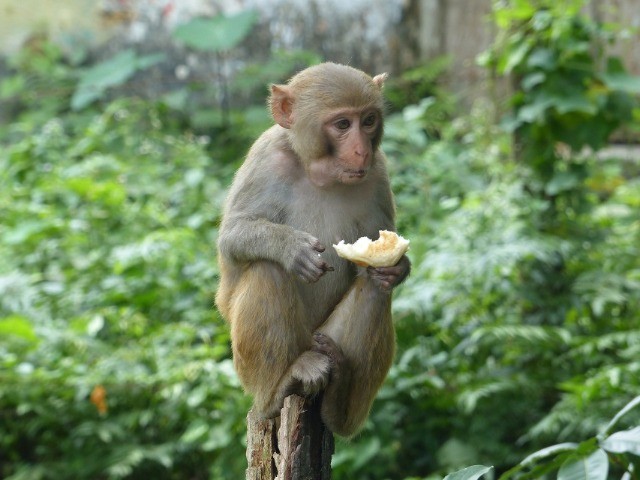A flash of black high up in the forest canopy, a symphony of gentle baby-like coos, a shower of leaves and debris: you’ve just found a group of Lion-tailed Macaques! Monkeys are highly entertaining to watch, and if you pay close attention, you may even learn a thing or two.
Of the 17 species of primates found in the Indian subcontinent, the Lion-tailed Macaque is perhaps the most unique. It stands out, particularly, in its appearance, behaviour and life history. The most striking feature of the Lion-tailed Macaque is, you guessed it, its lion-like tail and mane, and that’s just one of the many strange features of the species. Here are ten things you need to know about the Lion-tailed Macaque.
1 – Say hello to the Wanderoo!
The Lion-tailed Macaque (Macaca silenus) is a relatively small-sized macaque with a furless black face and a white ‘mane’. Covered in a thick coat of black fur, its short tail ends in a tuft, which is why it is known as the Lion-tailed Macaque. Once known as the ‘Wanderoo’ in the vernacular, the Lion-tailed Macaque, often referred to simply as the LTM, is usually found in troops of 15 or more. The monkey is endemic to the Western Ghats of southern India, and its range is quickly shrinking.
2 – Home is where the ghat is
The Lion-tailed Macaque can be observed on tree canopies of the Western Ghats rainforests, and nowhere else in the world. Historically, its population extended contiguously over the entire stretch of the Western Ghats, from Kerala in the south, to Maharashtra in the north. At present, however, the LTM population extends between the Kalakkad Hills in the Tirunelveli district of Tamil Nadu, at the southern extent of their distribution, to the north of the Sharavathi River in Karnataka.
Their distribution is heavily influenced by the distribution of plant species diversity, which in turn is determined by the regional climate and topography. LTMs are found exclusively in wet-evergreen forests, where they have evolved to feed on certain rainforest plant species, such as the fruits of Cullenia exarillata, which resembles the Durian fruit, and many species of fig found in these forests. The loss of this habitat across the Western Ghats has led to a significant shrinkage of the LTM distribution, resulting in their complete disappearance from Goa and Maharashtra.
3 – Headcount
It is a challenge to estimate population size accurately. There is very little information on LTM numbers, either erstwhile or current; most formal surveys are conducted on a small scale, concentrating on certain parts of their distribution. Given their shy disposition and the fact that much of their habitat across the Western Ghats is still dense and contiguous, it is difficult to measure the current population size in many areas. However, studies between 2003-2009 estimate that there are between 3000-4,500 individuals remaining in the wild. The Kerala and Karnataka forest departments have also been engaged in long-term scientific monitoring efforts to track LTM populations in the last four to five years.
4 – Monkeys that stay together
The monkeys spend most of their time foraging for fruits and small invertebrates during the day. Close to nightfall, they choose a tree to roost for the night. The young are often observed playing amongst themselves, with some little ones hanging off the tails of their older siblings; others engrossed in play-wrestling matches. A particularly frightened squeak from a little one will usually bring the mother or an adult to the vicinity, to retrieve the infant from its rough-and-tumble playmates. Although the adult members of the LTM troop interact relatively infrequently, pairs or triads may be observed grooming one another. If you are lucky, you may even witness a behaviour so human-like that it is almost comical: a mother struggling to groom its young that kicks and squeaks in impatience, wanting nothing more than to get back to playing with the other ‘kids’ in the troop.
5 – A threatened existence
The Lion-tailed Macaque is listed as ‘Endangered’ in the IUCN Red List, with less than 4000 individuals left in the wild. It is also listed in Appendix I of CITES, and Schedule I of the Indian Wildlife (Protection) Act, 1972. Multiple factors led to the gradual but consistent decline of the LTM population over a long period of time. The continuous degradation of rainforest habitats over the past centuries is presumably the biggest contributing factor. In the early 1800s, extensive logging to introduce tea and coffee monocultures led to the fragmentation of native rainforests, which would have exacerbated the threat to the habitat specialist LTM.
Apart from habitat degradation, fragmentation of the population is also a major issue: it creates isolated populations that form islands among production landscapes such as tea, coffee, and rubber plantations, which limit resources for the LTM and constrain them from dispersing, an inherent natural history trait.
You may also like to read
6 – This land is my land
Private ownership of land poses its own threats as well; it is unregulated by the forest department, so owners can change land use patterns and clear undergrowth for mono-crop plantations, resulting in the loss of resources crucial for the survival of the LTM. Additionally, continued logging and even hunting have often been cited as some of the many reasons for the decline of the LTM population. These causes may affect certain subpopulations of Lion-tailed Macaques more than others. Certain subpopulations, such as in the Anamalais, also face the year-round threat of vehicular traffic, occasionally resulting in the death of LTMs as roadkill.
7 – Conserving the Lion-tailed Macaque
It was only in the 1970s that the endangered Lion-tailed Macaque began to get some much-needed attention. That’s when state forest departments began to identify crucial areas for their conservation. Measures to conserve the Lion-tailed Macaque included the cessation of a hydroelectric project on the Kunthipuzha river in the Silent Valley and ultimately to its demarcation as a protected area.
Since then, there has been a continuous string of scientists – from the University of Mysore and the Salim Ali Centre for Ornithology and Natural History (SACON) – and NGOs such as Nature Conservation Foundation (NCF) who have dedicated efforts to investigating the demography, ecology and behaviour of the LTM. Recently, NCF implemented multiple conservation measures, including the installation of ‘bridges’ that help the monkeys travel in areas of discontinuous canopy. NCF also employs members of the local community to manage vehicular traffic when the monkeys descend onto roads that cut through forest fragments. There is also an active ongoing effort to educate local residents on the importance of conserving this iconic species.
8 – Sharing space with macaques
Taking into account the attitudes and willingness of local communities to conserve this species is of utmost importance as these two protagonists may interact with one another on a daily basis, each influencing the peaceful survival of the other. Humans and macaques living in close quarters may often face competition for food resources; lack of garbage disposal often attracts macaques to human habitation, which may lead to raiding for food; and non-monkey-proofed housing conditions create easy access for the macaques. In some areas, hunting is a known threat; however, it is not as prevalent, since it is legally prohibited, LTMs being a Schedule I animal in the Wildlife (Protection) Act.
Organisations and researchers that work in the field inevitably engage with the local communities, whether through formal sessions or even just to inform them of the work being conducted in the area and how it will benefit both them and the LTMs. Encouraging private companies to monkey-proof houses on their private land where LTM populations exist, is the next crucial step.
9 – Being Proactive
Stringent and proactive measures implemented on a case-by-case basis are our best hope to conserve this unique primate species. Active in situ conservation measures that are tailor-made for certain populations have definitely resulted in positive steps towards LTM conservation. For example, in the Sirsi-Honnavar belt, home to one of the largest wild populations of LTMs (~638 individuals), electric lines that pass through LTM habitat pose a threat of electrocution. Through the efforts of researchers from SACON, the Karnataka Forest Department began the process of insulating these electric lines in 2017; so far, half of the lines have been insulated, and the work continues. In areas such as the Valparai Plateau, where roads and vehicular traffic pose one of the greatest threats to the resident LTM population, the NCF and the Tamil Nadu forest department have installed six speed breakers to reduce the potential for roadkill.
Persistent conservation efforts have started showing results. After the implementation of these conservation measures, certain areas have shown improving trends in LTM numbers, although the changes are very gradual. As of 2009, the population of LTMs in Silent Valley has remained stable. In 2012, the Karnataka Forest Department declared an area of ~229 sq.km. in the Sirsi-Honnavar belt as the Aghanashini Lion-tailed Macaque Conservation Reserve, after recommendations from noted LTM researcher HN Kumara and other prominent conservationists.
10 – A ray of hope
There’s a lot we can do too. For one, remember: feeding LTMs is not an act of kindness. Being an informed audience is an important first step to help conserve the Lion-tailed Macaque. One of the first instincts that people have when encountering LTMs is to feed them, but it has been observed in many primate species that feeding on human-provided food has resulted in drastic shifts in their diet and behaviour, which may be detrimental to the long-term survival of the species. Moreover, food offerings made to monkeys encourage them to descend onto roads where vehicular traffic poses a major threat to their survival. We must remember that it is possible for all of us to raise our voices to influence policymakers, especially in tackling development projects and other directives that harm not only the LTM but many other taxa. Even these initial steps can contribute immensely to the conservation of the rare and beautiful Lion-tailed Macaque.
